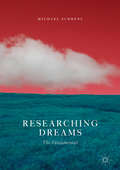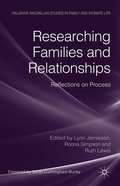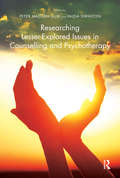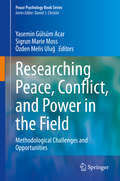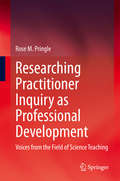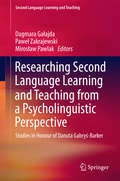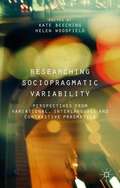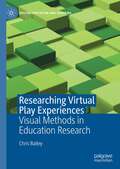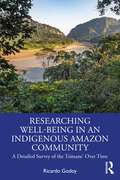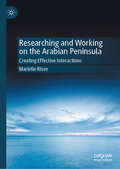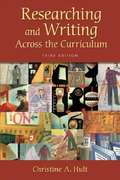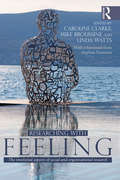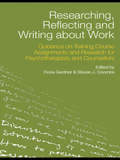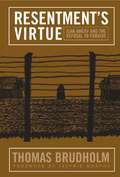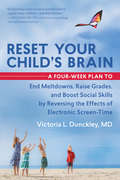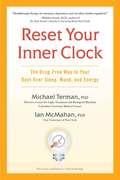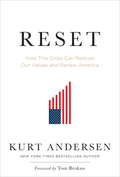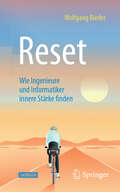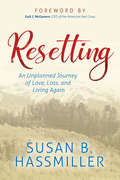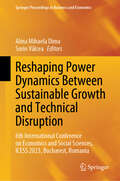- Table View
- List View
Researching Dreams: The Fundamentals
by Michael SchredlWhat can be gleaned from the study of our dreams? With research methods in mind—including the shortcomings and strengths of various strategies—the book presents a comprehensive introduction to the research obtained so far. Topics include the factors of dream recall; the continuity hypothesis of dreaming; the relationship between physiology and dream content; etiology and therapy of nightmares; and lucid dreaming. The book not only presents a comprehensive introduction to the research obtained so far but also provide the tools to carry our scientific dream studies—including the shortcomings and strengths of various approaches.
Researching Families and Relationships
by Ruth Lewis Lynn Jamieson Roona SimpsonThis collection focuses on the real life experiences of conducting emprical research about families and relationships, with an emphasis on the actualities of doing research and the experiences of being a researcher.
Researching Lesser-Explored Issues in Counselling and Psychotherapy
by Peter Madsen GubiThe authors have brought together important research into little-explored topics that are applicable to the field of counselling and psychotherapy. Each contributor has undertaken qualitative research into their chosen topic, and this book disseminates that research in a highly accessible manner. The aim of the volume is to inform counsellors and psychotherapists, and those in allied professions who support and care for people, towards developing a greater awareness of issues they may encounter. These include sexuality after breast cancer in young, single women; the impact of pregnancy loss on women who delayed childbirth and remain childless; adult reflections on being an only child; processing parental rejection through personal development; the nature of school-based counselling; the impact of emotional labour on secondary school teachers; and the impact of inappropriately referred clients on counselling trainees in placement.
Researching Peace, Conflict, and Power in the Field: Methodological Challenges and Opportunities (Peace Psychology Book Series)
by Yasemin Gülsüm Acar Sigrun Marie Moss Özden Melis UluğThis edited volume offers useful resources for researchers conducting fieldwork in various global conflict contexts, bringing together a range of international voices to relay important methodological challenges and opportunities from their experiences. The book provides an extensive account of how people do conflict research in difficult contexts, critically evaluating what it means to do research in the field and what the role of the researcher is in that context. Among the topics discussed:Conceptualizing the interpreter in field interviews in post-conflict settingsData collection with indigenous peopleChallenges to implementation of social psychological interventionsResearching children and young people’s identity and social attitudesInsider and outsider dynamics when doing research in difficult contextsWorking with practitioners and local organizations Researching Peace, Conflict, and Power in the Field is a valuable guide for students and scholars interested in conflict research, social psychologists, and peace psychologists engaged in conflict-related fieldwork.
Researching Practitioner Inquiry as Professional Development: Voices from the Field of Science Teaching
by Rose M. PringleThis book presents the authentic voices of science teachers engaged in practitioner inquiry as one component of a comprehensive professional development program. Practitioner inquiry as a genre of educational research, allows teachers to intentionally study their practices thus generating practical solutions to problems in their teaching and students’ learning. The teachers’ voices allowed us to enter their science classrooms to observe their posture and practices as reflective practitioners. They encountered issues such as culturally responsive teaching and low literacy proficiency and metacognitive skills among their struggling science learners. Their firsthand accounts provide new insights about practitioner inquiry as a tool to support teachers continuous learning, regardless of the disciplinary content areas. The book therefore provides a blueprint that can inform inservice teacher educators and support school and district administrators as they seek to nurture teachers’ professional growth.
Researching Second Language Learning and Teaching from a Psycholinguistic Perspective
by Mirosław Pawlak Dagmara Gałajda Paweł ZakrajewskiThis editedcollection explores the processes of secondlanguage learning and teaching from a psycholinguistic perspective. Authored by leading experts in the field, the book includes studies focusing on theoretical,empirical and practical aspects of second and foreign language education. PartOne offers contributionsdevoted to a range of learner-related factors, dealing with affective andcognitive variables, the process of reading and the acquisition of lexis. PartTwo brings together papers related to teacher awareness of second language instruction that focus on conversational styles, fostering interculturalpragmatics, teacher job satisfaction, the development of instructionalmaterials and challenges of teacher training in different contexts. It is of interest to researchers as well as graduate andpostgraduate students seeking fresh inspirations for their own empiricalinvestigations of the ways in which second and foreign languages are taught andlearned.
Researching Sex and Lies in the Classroom: Allegations of Sexual Misconduct in Schools
by Pat Sikes Heather PiperThe Anglophone world is gripped by a moral panic centred on child abuse in general and fear of the paedophile in particular. Evidence suggests an alarming rise in the number of false allegations of sexual abuse being made against teachers, and demonstrates that the fallout from being falsely accused is far-reaching and sometimes tragic. Many people in this position cannot sustain family relationships, have breakdowns, and are often unable to return to the classroom when their ordeal is over. Researching Sex and Lies in the Classroom draws on in-depth qualitative research exploring the experiences, perceptions and consequences for those who have been falsely accused of sexual misconduct with pupils, and for the family members, friends and colleagues affected by or involved in the accusation process. The book also highlights the dilemmas and difficulties the authors themselves have faced researching this field, such as: ethical and methodological concerns over whether or not the teachers had indeed been falsely accused, or were guilty and taking advantage of this project to construct an alternative, innocent identity the difficulty of obtaining institutional ethical clearance to undertake and publish research which challenges master narratives concerning children and their protection the reluctance of funders to support research in controversial and sensitive areas. Researching Sex and Lies in the Classroom reveals findings which are both informative and shocking. It interrogates the appropriateness of current investigative and judicial procedures and practices, and it raises general questions about the surveillance and control of research and academic voice. It will be of great benefit to academics and researchers interested in this field, as well as postgraduate students, teachers and other professionals working with the fear of allegations of abuse.
Researching Sociopragmatic Variability: Perspectives from Variational, Interlanguage and Contrastive Pragmatics
by Kate Beeching Helen WoodfieldResearching Sociopragmatic Variability showcases a range of research approaches to the study of speech acts and pragmatic markers across different languages and varieties of a language, investigating native and non-native usages and variation across gender, situation and addressee.
Researching Sociopragmatic Variability: Perspectives from Variational, Interlanguage and Contrastive Pragmatics
by Kate Beeching Helen WoodfieldResearching Sociopragmatic Variability showcases a range of research approaches to the study of speech acts and pragmatic markers across different languages and varieties of a language, investigating native and non-native usages and variation across gender, situation and addressee.
Researching Virtual Play Experiences: Visual Methods in Education Research (Digital Education and Learning)
by Chris BaileyThis book illuminates the lived experience of a group of primary school children engaged in virtual world play during a year-long after-school club. Shaped by post-structuralist theory and New Literacy Studies, it outlines a playful, participatory and emergent methodological approach, referred to as ‘rhizomic ethnography’. This ‘hybrid’ text uses both words and images to describe the fieldsite and the methodology, demonstrating how children’s creation of a digital community through Minecraft was shaped by the both the game and their wider social and cultural experiences. Through the exploration of various dimensions of the club, including visual and soundscape data, the author demonstrates the ‘emergent dimension of play’. It will be of interest and value to researchers of children’s play, as well as those who explore visual methods and design multimodal research outputs.
Researching Well-Being in an Indigenous Amazon Community: A Detailed Survey of the Tsimane' Over Time
by Ricardo GodoyThis book aims to provide the first comprehensive, multi‑year, systematic, quantitative assessment in the behavioral sciences of how well‑being changes over time in a small‑scale rural society of Indigenous People in the Global South.Using data compiled by the Tsimane’ Amazonian Panel Study (2002–010) that monitored change in Tsimane’ communities, this book analyzes economic, social, and health changes in a farming and foraging society of native Amazonians in Bolivia. It uses multidisciplinary methods to follow the same individuals, households, and village through time and bring together three themes: well‑eing, economic inequalities, and the fate of Indigenous People in small‑cale rural societies of the Global South. It finds considerable material deprivation, high economic inequalities within Tsimane’ society, and declining standards of living over time It ends by asking “Is this evidence that people adjust to anything or are these the costs Tsimane’ pay to retain autonomy and follow a historical lifestyle?”This book aims to provide a comprehensive approach to the measurement of well‑being and how to track its changes, providing a platform for future generations to gauge long‑term change. It will resonate with undergraduate and graduate students across the behavioral sciences, professional anthropologists who specialize in the Amazon or well‑being, development economists, and senior researchers who are part of the wave of emerging interest in doing research in small‑scale rural societies of the Global South.
Researching and Working on the Arabian Peninsula: Creating Effective Interactions
by Marielle RisseThis book outlines strategies for current or soon-to-be business professionals, government employees, researchers and teachers to communicate, study and work effectively on the Arabian Peninsula. Using first-person accounts, as well as scholarly research from the fields of history, anthropology, political science, travel writing and literature, this book gives clear advice for expats wanting to create successful interactions with people from Arabian Peninsula societies. By discussing how the practicalities of work and research intersect with cultural norms, this book fills the gap between tourist guides aimed at the causal tourists and academic texts on narrowly defined topics.
Researching and Writing Across the Curriculum (Third Edition)
by Christine A. HultThis thorough and engaging guide to research in the humanities, sciences, social sciences, and business teaches students to explore the entire research process, including intellectual inquiry and critical thinking. Researching and Writing Across the Curriculum provides discipline-specific guidance and sample papers that reflect differences in discourse and presentation in each discipline. The text also covers research methods and resources as they apply to all disciplines, with a comprehensive list of library resources and an introduction to the latest electronic and online resources. With thorough and up-to-date material on the impact of computers in research, and exercises that develop the skills of summarizing, synthesizing, and critiquing source materials, the text provides a complete guide that will aid students in all their college courses and beyond.
Researching the Autism Spectrum
by Ilona Roth Payam RezaieThis selection of contemporary research provides up-to-date perspectives from leading investigators who are at the cutting edge of studies in autism spectrum disorders. The book allows readers to grasp new approaches to understanding the autism spectrum. Key areas of theory and research are covered, from classification and diagnosis, genetics, neurology and biochemistry, to socio-cognitive, developmental and educational perspectives, essential to a broader understanding of the autism spectrum. In addition it introduces new emphases on MEG, epilepsy and memory. In highlighting both biomedical and psychological perspectives, this book reflects the multi-level emphasis of contemporary thinking about autism. By addressing key unanswered questions, Researching the Autism Spectrum acts as a guidepost for future research and provides an authoritative and multidisciplinary perspective.
Researching the Unconscious: Principles of Psychoanalytic Method (Tavistock Clinic Series)
by Michael RustinResearching the Unconscious provides an exposition of key issues in the philosophy and methods of the social sciences that are relevant to psychoanalysis, both as a clinical practice and as a human science. These include the debates initiated by Thomas Kuhn’s theory of scientific revolutions, the "actor-network theory" of Bruno Latour, the ideas of philosophical realism, distinctions between "meaningful" and "causal" explanation, and the relevance of complexity theory and "part–whole analysis" to psychoanalysis. The book goes on to discuss specific forms and methods of psychoanalytical research, including the role of case studies, of outcome research, and of "grounded theory" as a key methodological resource, of which it provides a detailed example. The book concludes by outlining principles and methods for psychoanalytic research in the wider contexts of infant observational studies, society, and culture. Michael Rustin provides a unifying account of the methodological principles that underlie the generation of knowledge in psychoanalysis, in the light of recent developments in the philosophy and sociology of science. In doing so, it provides a coherent rationale for psychoanalytic investigation, which will be of value to those pursuing research in this field. Researching the Unconscious is unusual in its being based both on a deep understanding of and respect for psychoanalytical clinical practice and on its author’s wider knowledge of the philosophy and sociology of science. It is unique in its comprehensive approach to the principles of psychoanalytic research.
Researching with Feeling: The Emotional Aspects of Social and Organizational Research
by Caroline Clarke Mike Broussine Linda WattsWhy should researchers be interested in their feelings and emotions as they carry out research? Emotion is what it is to exist, to be human, and is present in every sphere of our lives. All activities are infused with emotion, even those that are constructed as ‘rational’, because rationality and emotionality are interpenetrated and entwined because all thinking is tinged with feeling, and all feeling is tinged with thinking. This book illuminates the emotional processes of doing social and organizational research, and the implications of this for the outcomes of research. With contributions from leading academics and research practitioners, it addresses the significant issue of the sometimes intense emotional experiences involved in doing research and the implications it has for the theory and practice of social research. By examining the nature of feelings and emotions, it explores how we might understand researchers’ emotions and experiences, and considers the often powerful feelings encountered in a variety of research contexts. Topics discussed include: power relations; psycho-social explanations of researcher emotions; paradoxical relations with research participants and the sometimes disturbing data that is gained; research supervision; the politics of research; gender; publishing, undergoing vivas and presenting at conferences. This book will therefore be a valuable companion to researchers and research students from the start of their career onwards.
Researching, Reflecting and Writing about Work: Guidance on Training Course Assignments and Research for Psychotherapists and Counsellors
by Steven J. Coombs Fiona GardnerResearching, Reflecting and Writing about Work provides a guide to the research skills and critical thinking required to complete a research project for professional learning courses in counselling and psychotherapy. Written at a level easily accessible to those enrolled on a work-based qualification as well as those considering postgraduate research at master's level, this book includes: how we reflect on our work discussion on preparation and structuring of a case study how to present work in supervision with advice on process recording essay plan structures and appropriate methodologies for research ethical considerations and critical linking dilemmas and tensions involved in ‘research at work’. Key learning points and reflective exercises are included throughout and theory is supported by contributions detailing specific learning experiences from a variety of work settings, including the public sector, an organisation, in the community, and as an independent counsellor in a voluntary agency. There is also a section on how to prepare your research for consideration for publication and how to present your findings to colleagues. Researching, Reflecting and Writing about Work will be of interest to all those on counselling courses, or training as psychotherapists, as well as people involved in professional learning linked to the helping professions, including those interested in work-based research linked to therapy in any setting.
Resentment's Virtue: Jean Amery and the Refusal to Forgive
by Thomas BrudholmMost current talk of forgiveness and reconciliation in the aftermath of collective violence proceeds from an assumption that forgiveness is always superior to resentment and refusal to forgive. Victims who demonstrate a willingness to forgive are often celebrated as virtuous moral models, while those who refuse to forgive are frequently seen as suffering from a pathology. Resentment is viewed as a negative state, held by victims who are not "ready" or "capable" of forgiving and healing. Resentment's Virtue offers a new, more nuanced view. Building on the writings of Holocaust survivor Jean Améry and the work of the South African Truth and Reconciliation Commission, Thomas Brudholm argues that the preservation of resentment can be the reflex of a moral protest that might be as permissible, humane or honorable as the willingness to forgive. Taking into account the experiences of victims, the findings of truth commissions, and studies of mass atrocities, Brudholm seeks to enrich the philosophical understanding of resentment.
Reset Your Child's Brain: A Four-Week Plan to End Meltdowns, Raise Grades, and Boost Social Skills by Reversing the Effects of Electronic Screen-Time
by Victoria L. Dunckley, MDIncreasing numbers of parents grapple with children who are acting out without obvious reason. Revved up and irritable, many of these children are diagnosed with ADHD, bipolar illness, autism, or other disorders but don’t respond well to treatment. They are then medicated, often with poor results and unwanted side effects. Based on emerging scientific research and extensive clinical experience, integrative child psychiatrist Dr. Victoria Dunckley has pioneered a four-week program to treat the frequent underlying cause, Electronic Screen Syndrome (ESS). Dr. Dunckley has found that everyday use of interactive screen devices — such as computers, video games, smartphones, and tablets — can easily overstimulate a child’s nervous system, triggering a variety of stubborn symptoms. In contrast, she’s discovered that a strict, extended electronic fast single-handedly improves mood, focus, sleep, and behavior, regardless of the child’s diagnosis. It also reduces the need for medication and renders other treatments more effective. Offered now in this book, this simple intervention can produce a life-changing shift in brain function and help your child get back on track — all without cost or medication. While no one in today’s connected world can completely shun electronic stimuli, Dr. Dunckley provides hope for parents who feel that their child has been misdiagnosed or inappropriately medicated, by presenting an alternative explanation for their child’s difficulties and a concrete plan for treating them.
Reset Your Inner Clock
by Michael Terman Ian McmahanAn enlightened approach to insomnia, depressed mood, fatigue, and other sleep-related problems of everyday life, harnessing the power of light therapy to reset the natural clock. Sleep problems and depressed mood often go hand in hand, forming a frustrating cycle. Michael Terman, Ph.D., has devoted his career to studying the brain functions that feed these disorders. In Reset Your Inner Clock, Terman and Ian McMahan, Ph.D., reveal the heart of his findings, a powerful program that recalibrates our internal clocks--our exquisitely designed, natural sensitivity to the timing and brightness of light exposure. These delicate mechanisms are often decimated by the modern demands of a 24/7 lifestyle. Beginning with a questionnaire that pinpoints the problem areas, Terman helps readers decipher when their natural internal night begins and ends. The treatment process can then start, incorporating the power of natural light and, when necessary, supplemental light therapy. His approach has brought relief to thousands of sleep sufferers, as well as those burdened by bipolar disorder, seasonal affective disorder, depression, sleep disorders due to around-the-clock work schedules, and other impediments to vibrant health. For the first time, his findings are now available for a general audience, sharing the essential elements of chronobiology in clear, authoritative, scientifically grounded chapters that are easy to apply to a variety of situations.
Reset: How This Crisis Can Restore Our Values and Renew America
by Kurt Andersen"This is the end of the world as we've known it," Kurt Andersen writes in Reset. "But it isn't the end of the world." In this smart and refreshingly hopeful book, Andersen--a brilliant analyst and synthesizer of historical and cultural trends, as well as a bestselling novelist and host of public radio's Studio 360--shows us why the current economic crisis is actually a moment of great opportunity to get ourselves and our nation back on track. Historically, America has always shifted between wild, exuberant speculation and steady, sober hard work, as well as back and forth between economic booms and busts, and between right and left politically. This is one of the rare moments when all these cycles shift dramatically and simultaneously--a moment when complacency ends, ossified structures loosen up, and enormous positive change is possible. The shock to the system can enable each of us to rethink certain habits and focus more on the things that make us authentically happy. The present flux can enable us as a society to consolidate the enormous gains of the last several decades in areas such as technology, crime prevention, women's and civil rights, and the democratization of the planet. We can reap the fruits of a revival of realism and pragmatism at home and abroad. As we enter a new era of post-party-line common sense, we can start to reinvent hopelessly broken systems-in health care, education, climate change, and more-and rediscover some of the old-fashioned American values of which we've lost sight. In Reset, Andersen explains how we've done it before and why we are about to do it again--and better than ever.
Reset: Wie Ingenieure und Informatiker innere Stärke finden
by Wolfgang RiederDas Buch behandelt die Balance zwischen beruflicher Leistung und persönlichem Wohlbefinden, speziell für Ingenieure, Techniker und IT-Profis. Es zeigt, wie man in einer zunehmend digitalisierten und stressigen Welt innere Stärke und Resilienz entwickeln kann. Das Buch richtet sich in erster Linie an Ingenieure, Techniker und IT-Profis, die sich in einer anspruchsvollen, leistungsorientierten Arbeitswelt befinden. Darüber hinaus eignet es sich für alle, die in technischen oder stressbelasteten Berufen arbeiten und nach Wegen suchen, Stress zu reduzieren, Resilienz aufzubauen und ein erfülltes Leben zu führen. Die fortschreitende Digitalisierung und Automatisierung prägen unsere Arbeitswelt wie nie zuvor. Ständige Erreichbarkeit, hohe Anforderungen und die zunehmende Angst vor Ersetzbarkeit durch KI und Maschinen machen das Thema aktueller denn je. Gleichzeitig wächst das Bewusstsein für mentale Gesundheit und persönliche Resilienz, insbesondere nach den Herausforderungen der letzten Jahre wie der Pandemie. Mein Buch greift diese gesellschaftlichen Veränderungen auf und bietet praktische Lösungsansätze, die direkt umsetzbar sind.
Resetting: An Unplanned Journey of Love, Loss, and Living Again
by Susan B. HassmillerResetting shares the story of a personal grief journey and helps transform today’s understanding of the human condition. Although grief and loss are universal human conditions around since the beginning of time, the idea of loss is still greatly feared, ignored, distained, undiscussed, and certainly not prepared for. It is no wonder people feel alone and isolated in their feelings and thoughts when loss comes to them. Longtime nurse, Susan Beth Hassmiller, who is no stranger to death, has experienced the journeys of suffering and death in her patients as well as her personal life in which she was completely blindsided by the physical, spiritual, and emotional toll.Resetting is written in a daily diary format in which Susan opens a very private window to the actual feelings and thoughts she experienced in the grief process. Resetting is raw and gripping as it illustrates a new level of understanding of the human condition. Susan helps those who have suffered loss gain a new perception and a greater sense of grief while learning lessons on how to help those suffering from grief—from words to say to tasks to take on.
Resexualising Later Life: Performances of Older Sexual Citizenship (Sex and Intimacy in Later Life)
by Paul Reynolds, Paul Simpson and Trish Hafford-LetchfieldBuilding on the work of the previous volumes in the Sex and Intimacy in Later Life series, this book explores how resexualisation may take place in later life. Drawing on transdisciplinary and international content, it provides a theoretically and experientially informed overview and discussion of resexualisation, highlighting important areas of research in a nascent area of study. This volume covers a range of sexual identities and ageing populations, blending cultural representations and current research to highlight the possible forms and practices that can lead to the creative enabling of pleasure.
Reshaping Power Dynamics Between Sustainable Growth and Technical Disruption: 6th International Conference on Economics and Social Sciences, ICESS 2023, Bucharest, Romania (Springer Proceedings in Business and Economics)
by Alina Mihaela Dima Sorin VâlceaThis book covers various topics related to economics and the social sciences, such as artificial intelligence, sustainability, ESG, and tax administration. The respective contributions provide insights and perspectives on the current challenges and opportunities in these fields, while also showcasing the latest research and innovations from scholars and practitioners around the world. The book is based on the papers presented at the 6th International Conference on Economics and Social Sciences, ICESS 2023, which was held in Bucharest, Romania.
